Abstract
Leucine-enkephalin, methionine-enkephalin, and morphine caused a reversible block of Ca2+ channel currents in neuroblastoma-glioma hybrid cells (NG108-15). The long-lasting (type 2) component of the Ca2+ channel current was blocked by leucine-enkephalin, while the transient (type 1) component was not affected. The enkephalin-induced blocking action was antagonized by naloxone and appears to be mediated by delta-opiate receptors. Two different aspects of the blocking effect were detected, a resting block and a recovery from block during prolonged depolarizing pulses. Recovery from block was more complete, and its time course was more rapid, with depolarization to more positive potentials. The dose dependence of the type 2 channel block at rest indicated a one-to-one binding stoichiometry, with an apparent dissociation constant of 8.8 nM. Somatostatin exerted a similar selective blocking action on the type 2 Ca2+ channel. The time- and voltage-dependent block of type 2 Ca2+ channels may provide a mechanism underlying the enkephalinergic presynaptic inhibition of transmitter release and the somatostatin block of pituitary growth hormone release.
Full text
PDF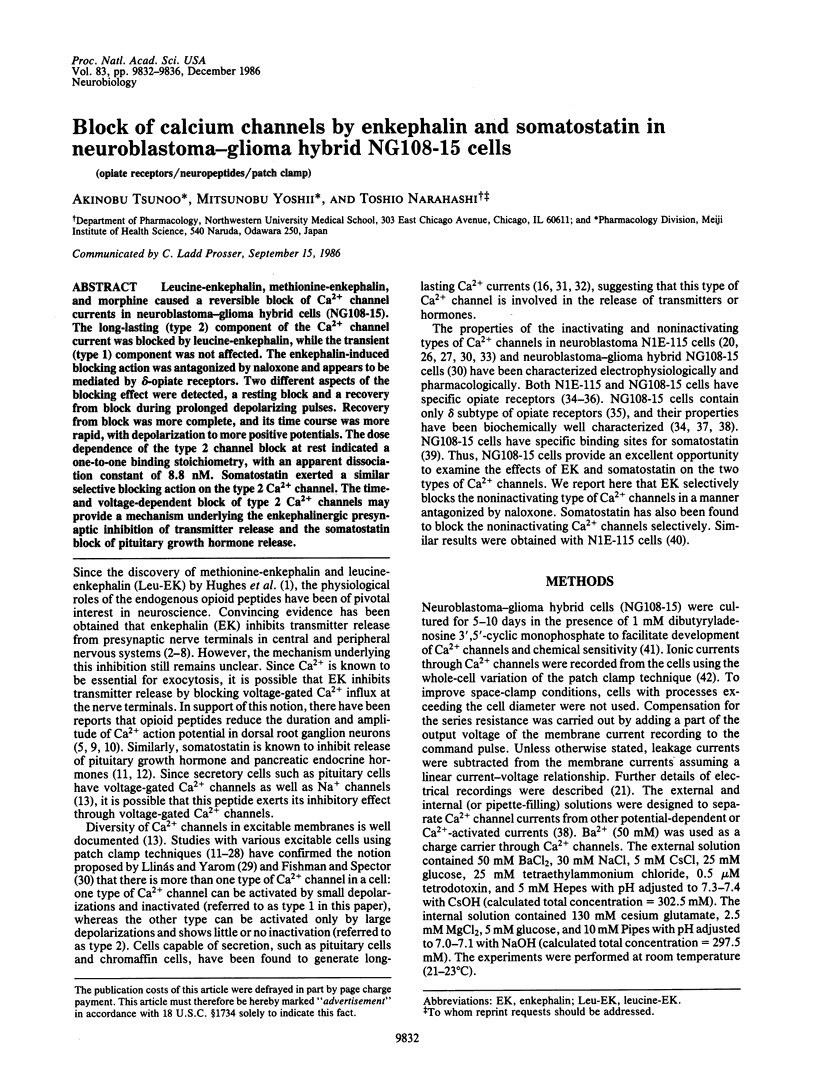
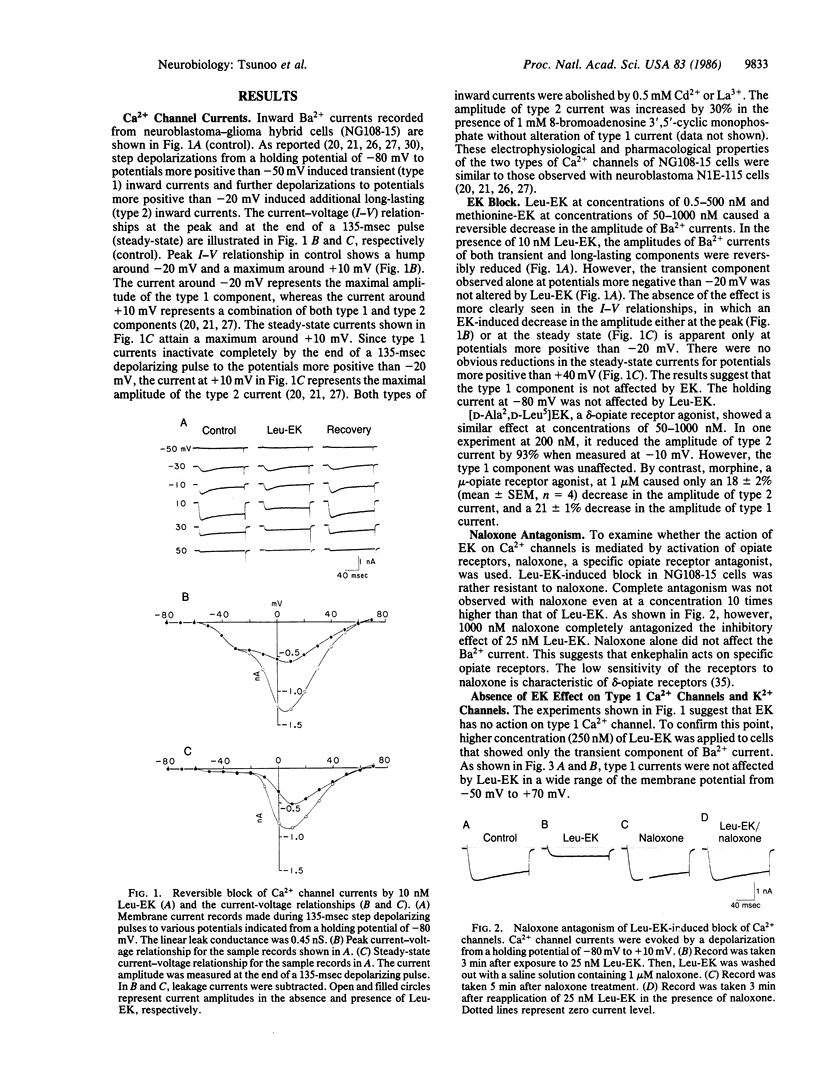
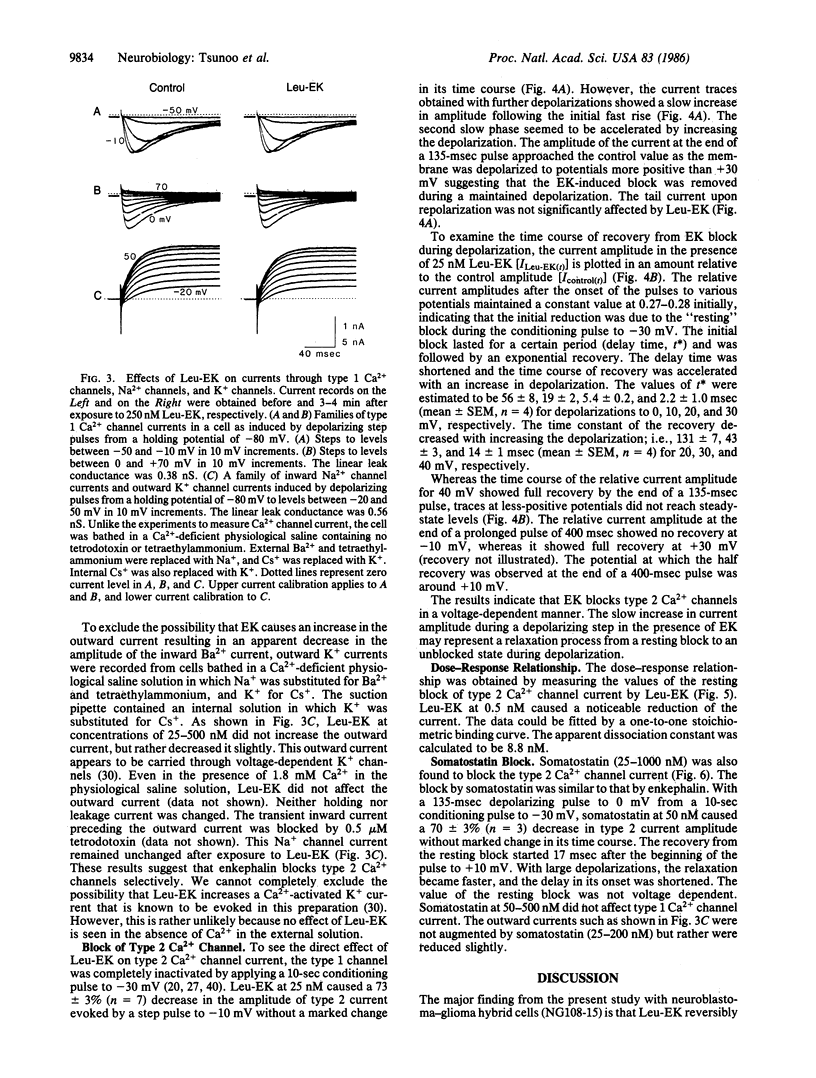
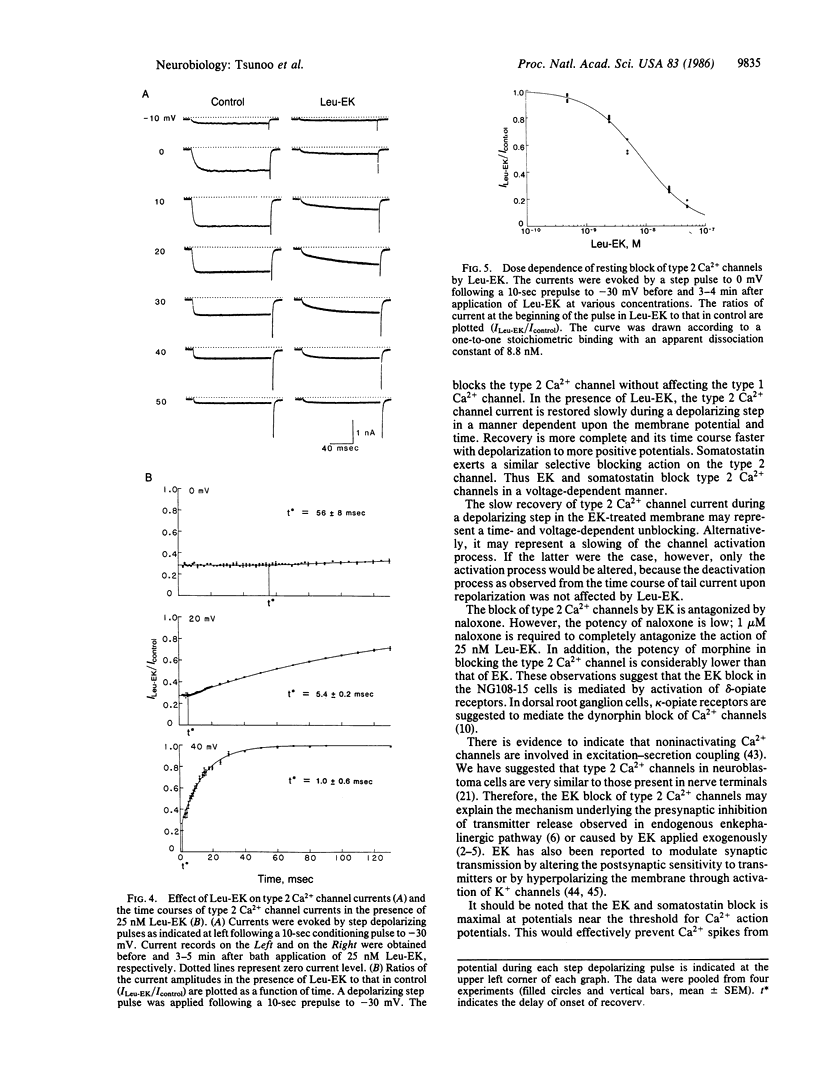
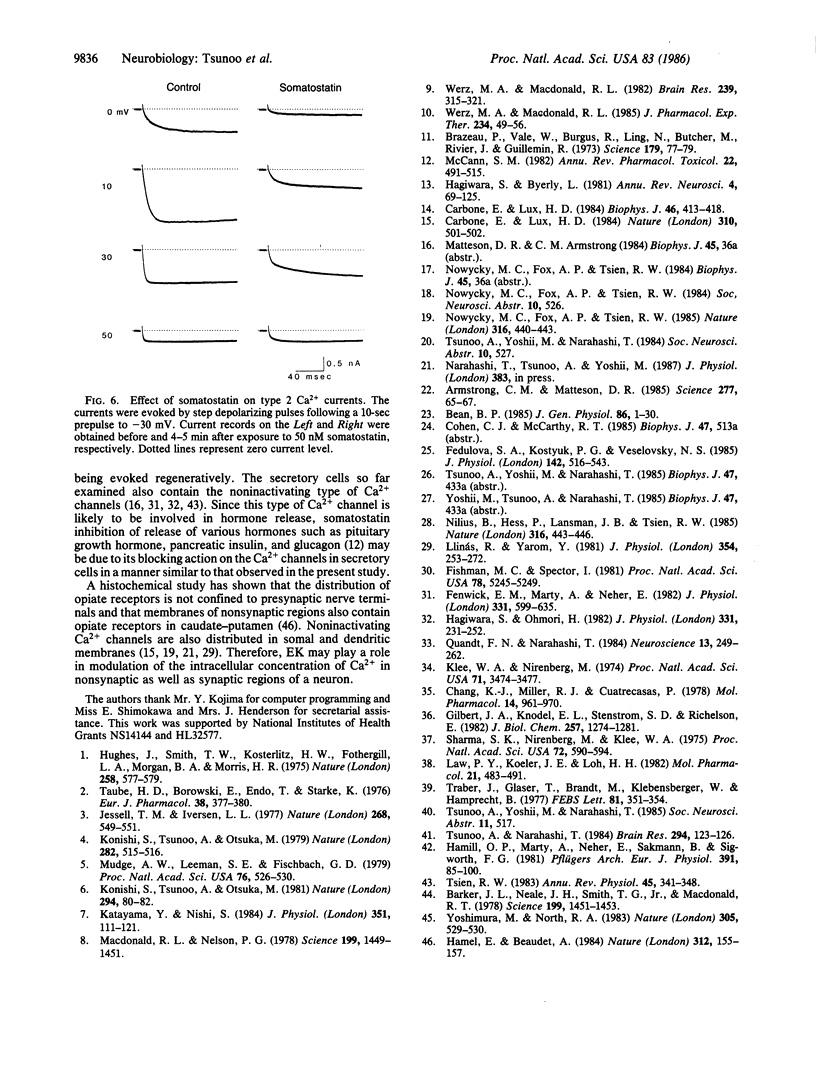
Selected References
These references are in PubMed. This may not be the complete list of references from this article.
- Armstrong C. M., Matteson D. R. Two distinct populations of calcium channels in a clonal line of pituitary cells. Science. 1985 Jan 4;227(4682):65–67. doi: 10.1126/science.2578071. [DOI] [PubMed] [Google Scholar]
- Barker J. L., Neale J. H., Smith T. G., Jr, Macdonald R. L. Opiate peptide modulation of amino acid responses suggests novel form of neuronal communication. Science. 1978 Mar 31;199(4336):1451–1453. doi: 10.1126/science.204016. [DOI] [PubMed] [Google Scholar]
- Bean B. P. Two kinds of calcium channels in canine atrial cells. Differences in kinetics, selectivity, and pharmacology. J Gen Physiol. 1985 Jul;86(1):1–30. doi: 10.1085/jgp.86.1.1. [DOI] [PMC free article] [PubMed] [Google Scholar]
- Brazeau P., Vale W., Burgus R., Ling N., Butcher M., Rivier J., Guillemin R. Hypothalamic polypeptide that inhibits the secretion of immunoreactive pituitary growth hormone. Science. 1973 Jan 5;179(4068):77–79. doi: 10.1126/science.179.4068.77. [DOI] [PubMed] [Google Scholar]
- Carbone E., Lux H. D. A low voltage-activated calcium conductance in embryonic chick sensory neurons. Biophys J. 1984 Sep;46(3):413–418. doi: 10.1016/S0006-3495(84)84037-0. [DOI] [PMC free article] [PubMed] [Google Scholar]
- Carbone E., Lux H. D. A low voltage-activated, fully inactivating Ca channel in vertebrate sensory neurones. Nature. 1984 Aug 9;310(5977):501–502. doi: 10.1038/310501a0. [DOI] [PubMed] [Google Scholar]
- Chang K. J., Miller R. J., Cuatrecasas P. Interaction of enkephalin with opiate receptors in intact cultured cells. Mol Pharmacol. 1978 Nov;14(6):961–970. [PubMed] [Google Scholar]
- Fenwick E. M., Marty A., Neher E. Sodium and calcium channels in bovine chromaffin cells. J Physiol. 1982 Oct;331:599–635. doi: 10.1113/jphysiol.1982.sp014394. [DOI] [PMC free article] [PubMed] [Google Scholar]
- Fishman M. C., Spector I. Potassium current suppression by quinidine reveals additional calcium currents in neuroblastoma cells. Proc Natl Acad Sci U S A. 1981 Aug;78(8):5245–5249. doi: 10.1073/pnas.78.8.5245. [DOI] [PMC free article] [PubMed] [Google Scholar]
- Gilbert J. A., Knodel E. L., Stenstrom S. D., Richelson E. Function and regulation of methionine5-enkephalin and its receptors in murine neuroblastoma cells. J Biol Chem. 1982 Feb 10;257(3):1274–1281. [PubMed] [Google Scholar]
- Hagiwara S., Byerly L. Calcium channel. Annu Rev Neurosci. 1981;4:69–125. doi: 10.1146/annurev.ne.04.030181.000441. [DOI] [PubMed] [Google Scholar]
- Hagiwara S., Ohmori H. Studies of calcium channels in rat clonal pituitary cells with patch electrode voltage clamp. J Physiol. 1982 Oct;331:231–252. doi: 10.1113/jphysiol.1982.sp014371. [DOI] [PMC free article] [PubMed] [Google Scholar]
- Hamel E., Beaudet A. Electron microscopic autoradiographic localization of opioid receptors in rat neostriatum. Nature. 1984 Nov 8;312(5990):155–157. doi: 10.1038/312155a0. [DOI] [PubMed] [Google Scholar]
- Hamill O. P., Marty A., Neher E., Sakmann B., Sigworth F. J. Improved patch-clamp techniques for high-resolution current recording from cells and cell-free membrane patches. Pflugers Arch. 1981 Aug;391(2):85–100. doi: 10.1007/BF00656997. [DOI] [PubMed] [Google Scholar]
- Hughes J., Smith T. W., Kosterlitz H. W., Fothergill L. A., Morgan B. A., Morris H. R. Identification of two related pentapeptides from the brain with potent opiate agonist activity. Nature. 1975 Dec 18;258(5536):577–580. doi: 10.1038/258577a0. [DOI] [PubMed] [Google Scholar]
- Jessell T. M., Iversen L. L. Opiate analgesics inhibit substance P release from rat trigeminal nucleus. Nature. 1977 Aug 11;268(5620):549–551. doi: 10.1038/268549a0. [DOI] [PubMed] [Google Scholar]
- Katayama Y., Nishi S. Sites and mechanisms of actions of enkephalin in the feline parasympathetic ganglion. J Physiol. 1984 Jun;351:111–121. doi: 10.1113/jphysiol.1984.sp015236. [DOI] [PMC free article] [PubMed] [Google Scholar]
- Klee W. A., Nirenberg M. A neuroblastoma times glioma hybrid cell line with morphine receptors. Proc Natl Acad Sci U S A. 1974 Sep;71(9):3474–3477. doi: 10.1073/pnas.71.9.3474. [DOI] [PMC free article] [PubMed] [Google Scholar]
- Konishi S., Tsunoo A., Otsuka M. Enkephalin as a transmitter for presynaptic inhibition in sympathetic ganglia. Nature. 1981 Nov 5;294(5836):80–82. doi: 10.1038/294080a0. [DOI] [PubMed] [Google Scholar]
- Konishi S., Tsunoo A., Otsuka M. Enkephalins presynaptically inhibit cholinergic transmission in sympathetic ganglia. Nature. 1979 Nov 29;282(5738):515–516. doi: 10.1038/282515a0. [DOI] [PubMed] [Google Scholar]
- Law P. Y., Koehler J. E., Loh H. H. Comparison of opiate inhibition of adenylate cyclase activity in neuroblastoma N18tG2 and neuroblastoma x glioma NG108-15 hybrid cell lines. Mol Pharmacol. 1982 Mar;21(2):483–491. [PubMed] [Google Scholar]
- Macdonald R. L., Nelson P. G. Specific-opiate-induced depression of transmitter release from dorsal root ganglion cells in culture. Science. 1978 Mar 31;199(4336):1449–1451. doi: 10.1126/science.204015. [DOI] [PubMed] [Google Scholar]
- McCann S. M. Physiology and pharmacology of LHRH and somatostatin. Annu Rev Pharmacol Toxicol. 1982;22:491–515. doi: 10.1146/annurev.pa.22.040182.002423. [DOI] [PubMed] [Google Scholar]
- Mudge A. W., Leeman S. E., Fischbach G. D. Enkephalin inhibits release of substance P from sensory neurons in culture and decreases action potential duration. Proc Natl Acad Sci U S A. 1979 Jan;76(1):526–530. doi: 10.1073/pnas.76.1.526. [DOI] [PMC free article] [PubMed] [Google Scholar]
- Nilius B., Hess P., Lansman J. B., Tsien R. W. A novel type of cardiac calcium channel in ventricular cells. Nature. 1985 Aug 1;316(6027):443–446. doi: 10.1038/316443a0. [DOI] [PubMed] [Google Scholar]
- Nowycky M. C., Fox A. P., Tsien R. W. Three types of neuronal calcium channel with different calcium agonist sensitivity. Nature. 1985 Aug 1;316(6027):440–443. doi: 10.1038/316440a0. [DOI] [PubMed] [Google Scholar]
- Quandt F. N., Narahashi T. Isolation and kinetic analysis of inward currents in neuroblastoma cells. Neuroscience. 1984 Sep;13(1):249–262. doi: 10.1016/0306-4522(84)90275-6. [DOI] [PubMed] [Google Scholar]
- Sharma S. K., Nirenberg M., Klee W. A. Morphine receptors as regulators of adenylate cyclase activity. Proc Natl Acad Sci U S A. 1975 Feb;72(2):590–594. doi: 10.1073/pnas.72.2.590. [DOI] [PMC free article] [PubMed] [Google Scholar]
- Taube H. D., Borowski E., Endo T., Starke K. Enkephalin: a potential modulator of noradrenaline release in rat brain. Eur J Pharmacol. 1976 Aug;38(2):377–380. doi: 10.1016/0014-2999(76)90343-5. [DOI] [PubMed] [Google Scholar]
- Traber J., Glaser T., Brandt M., Klebensberger W., Hamprecht B. Different receptors for somatostatin and opioids in neuroblastoma X glioma hybrid cells. FEBS Lett. 1977 Sep 15;81(2):351–354. doi: 10.1016/0014-5793(77)80552-8. [DOI] [PubMed] [Google Scholar]
- Tsien R. W. Calcium channels in excitable cell membranes. Annu Rev Physiol. 1983;45:341–358. doi: 10.1146/annurev.ph.45.030183.002013. [DOI] [PubMed] [Google Scholar]
- Tsunoo A., Narahashi T. Cyclic AMP-mediated potentiation of muscarinic hyperpolarization in neuroblastoma cells. Brain Res. 1984 Feb 27;294(1):123–126. doi: 10.1016/0006-8993(84)91315-5. [DOI] [PubMed] [Google Scholar]
- Werz M. A., Macdonald R. L. Dynorphin and neoendorphin peptides decrease dorsal root ganglion neuron calcium-dependent action potential duration. J Pharmacol Exp Ther. 1985 Jul;234(1):49–56. [PubMed] [Google Scholar]
- Werz M. A., Macdonald R. L. Opioid peptides decrease calcium-dependent action potential duration of mouse dorsal root ganglion neurons in cell culture. Brain Res. 1982 May 6;239(1):315–321. doi: 10.1016/0006-8993(82)90859-9. [DOI] [PubMed] [Google Scholar]
- Yoshimura M., North R. A. Substantia gelatinosa neurones hyperpolarized in vitro by enkephalin. Nature. 1983 Oct 6;305(5934):529–530. doi: 10.1038/305529a0. [DOI] [PubMed] [Google Scholar]


